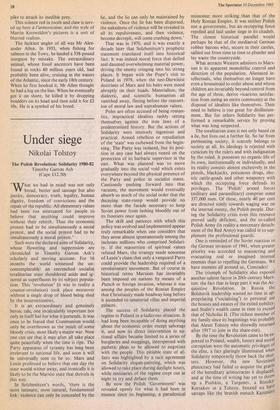Violent deaths
Adam Nicolson
The New Compleat Angler Stephen Downes, illustrated by Martin Knowelden (Orbis £9.95)
Isaak Walton recommends a live yellow 'frog as the best bait when angling for pike. 'Put your hook through his mouth,' he says in the original Compleat Angler, 'and out at the gills, and then with a fine needle and silk sew the upper part of his leg with only one stitch to the arming wire of your hook; and in so doing, use him as though you loved him, that is, harm him as little as you may possibly, that he may live the longer.' This sort of careful cruelty, described in a tone of perfect innocence (Walton thought fishing was 'an honest, in- genuous, quiet and harmless art'), is typical of the angling mind. As far as I can tell, Walton was quite unaware that to do this to
a living frog, and then to hang it mid- stream for a pike to eat, was cruel either to the frog or to the pike. Real ingenuousness (one of Walton's favourite words) can ap- parently accommodate cruelty without noticing. It would be absurd to call the pike cruel for taking the dangled frog.
On the 15 December it will be 300 years since Walton died. The New Compleat Angler celebrates the tercentenary. The same tone of relaxed indifference runs through both the New and the Old. 'This trout looks lovely,' Walton makes his Piscator say, 'it was twentie two inches when it was taken, and the belly of it looked yellow as a Marigold and white as a Lily, and yet methinks it looks better in this good sawce.' Dr Downes, the author of the modern version, shares the attitude, passing from a discussion of the natural habitat of the pike to the best way of cooking it in 'the beurre blanc of the Loire valley'. From source to mouth, so to speak.
Modern methods go further than Walton can have imagined. Dr Downes, an expert in DNA repair, is fascinating if contentious on the natural history of both fishermen and fish, and shares all Walton's suscep- tibility to half-relevant anecdotes. A perch, he maintains, is almost certainly conscious of its own silver beauty, and those anglers who have devoted their lives to the quest for the one-ounce minnow (the current British record stands at nine drachms) are almost certainly unconscious of theirs.
But angling, like dentistry, is an art in which success and torture are quite in- separable. In order to learn the prodigious amount now known about the way fish behave, scientists have frozen them alive in blocks of ice and then unfrozen them to see if they survive (they do — for a day); am- putated fins and tails to observe how fish move and balance without the means to do so; electrocuted trout; removed a fish's eyes and cut the nerve to its 'lateral line' — the complex hearing system that runs along its flank — to find that 'deprived of both senses it will wander about helplessly'; and put a pike alone in a tank for a week with a stickleback, waiting until hunger forced the
pike to attack its inedible prey.
This science red in tooth and claw is serv- ed up here a l'unnoricaine, and the style of Martin Knowelden's pictures is a sort of blurred realism.
The luckiest angler of all was Mr Alex- ander Allen. In 1933, when fishing for salmon in the Towy, he landed a 338-pound sturgeon by mistake. The extraordinary animal, whose fossil ancestors have been found in rocks 60 million years old, had probably been alive, cruising in the waters of the Atlantic, since the early 18th century. When he first hooked it, Mr Allen thought he had a log on the line. When he eventually got it on shore, he killed it by dropping boulders on its head and then sold it for £2 10s. He is a symbol of his breed.















































 Previous page
Previous page